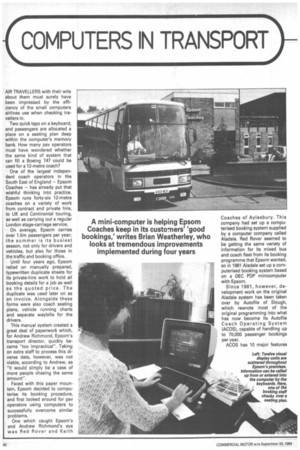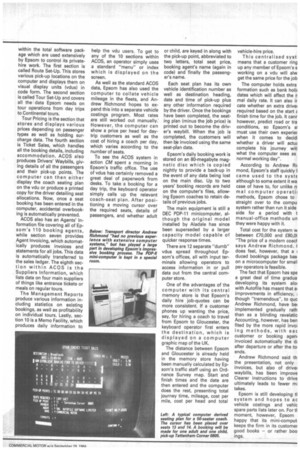A mini-computer is helping Epsom Coaches keep in its customers'
Page 42

Page 43

If you've noticed an error in this article please click here to report it so we can fix it.
good bookings,' writes Brian Weatherley, who looks at tremendous improvements implemented during four years
AIR TRAVELLERS with their wits about them must surely have been impressed by the efficiency of the small computers airlines use when checking travellers in.
Two quick taps on a keyboard, and passengers are allocated a place on a seating plan deep within the computer's memory bank. How many psv operators must have wondered whether the same kind of system that can fill a Boeing 747 could be used for a 12-metre coach?
One of the largest independent coach operators in the South East of England — Epsom Coaches — has already put that wishful thinking into practice. Epsom runs forty-six 12-metre coaches on a variety of work from contract and private hire, to UK and Continental touring, as well as carrying out a regular London stage-carriage service.
On average, Epsom carries over 1.5m passengers per year; the summer is its busiest season, not only for drivers and vehicles, but also for those in the traffic and booking office.
Until four years ago, Epsom relied on manually prepared, typewritten duplicate sheets for its private-hire work to hold all booking details for a job as well as the quoted price. The duplicate was used later on as an invoice. Alongside these forms were also coach seating plans, vehicle running charts and separate waybills for the drivers.
This manual system created a great deal of paperwork which, for Andrew Richmond, Epsom's transport director, quickly became "too impractical". Taking on extra staff to process this diverse data, however, was not viable, according to Andrew, as "it would simply be a case of more people chasing the same amount".
Faced with this paper mountain, Epsom decided to computerise its booking procedure, and first looked around for psv operators using computers to successfully overcome similar problems.
One which caught Epsom's and Andrew Richmond's eye was Red Rover and Keith Coaches of Aylesbury. This company had set up a computerised booking system supplied by a computer company called Aladale. Red Rover seemed to be getting the same variety of information for its mixed bus and coach fleet from its booking programme that Epsom wanted, so in 1981 Aladale set up a computerised booking system based on a DEC PDP minicomputer with Epsom.
Since 1981, however, development work on the original Aladale system has been taken over by Autofile of Slough, which rewrote most of the original programming into what has now become its Autofile Coach Operating System {ACOS), capable of handling up to 70,000 passenger bookings per year.
ACOS has 10 major features within the total software package which are used extensively by Epsom to control its privatehire work. The first section is called Route Set-Up. This stores various pick-up locations on the computer and displays them on visual display units (vdus) in code form. The second section is called Tour Set-Up and covers all the data Epsom needs on tour operations from day trips to Continental tours.
Tour Pricing is the section that stores and displays various prices depending on passenger types as well as holding surcharge data. The fourth section is Ticket Sales, which handles all the booking details, including accommodation. ACOS also produces Drivers' Waybills, giving details of all the passengers and their pick-up points. The computer can then either display the coach seating plan on the vdu or produce a printed copy for the driver detailing seat allocations. Now, once a seat booking has been entered in the computer, accidental overbooking is automatically prevented.
ACOS also has an Agents' Information file covering all of Epsom's 110 booking agents, while section seven provides Agent Invoicing, which automatically produces invoices and statements for all jobs. This data is automatically transferred to the sales ledger. The eighth section within ACOS is the Suppliers Information, which lists data on four main suppliers of things like entrance tickets•or meals on regular tours.
The Management Reports produce various information including statistics on existing bookings, as well as profitability on individual tours. Lastly, section 10 is a Memo Facility, which produces daily information to help the vdu users. To get to any of the 10 sections within ACOS, an operator simply uses a standard "menu" or index which is displayed on the screen.
As well as the standard ACOS data, Epsom has also used the computer to collate vehicle mileage in the fleets, and Andrew Richmond hopes to expand this into a separate vehicle costings program. Most rates are still worked out manually. However, the computer can show a price per head for daytrip customers as well as the cost of hiring a coach per day, which varies according to the number of seats.
To see the ACOS system in action CM spent a morning in Epsom's traffic office. The use of vdus has certainly removed a great deal of paperwork from desks. To take a booking for a day trip, the keyboard operator simply calls up the relevant coach-seat plan. After positioning a moving cursor over the required seats, details of passengers, and whether adult or child, are keyed in along with the pick-up point, abbreviated to two letters, total seat price, booking agent's name (again in code) and finally the passenger's name.
Each seat plan has its own vehicle identification number as well as destination heading, date and time of pick-up plus any other information required by the driver. Once the bookings have been completed, the seating plan (minus the job price) is printed out to become the driver's waybill. When the job is completed, the customers will then be invoiced using the same seat-plan data.
Epsom's daily booking work is stored on an 80-megabyte magnetic disc which is copied nightly to provide a back-up in the event of any data being lost on the main disc. Up to two years' booking records are held on the computer's files, allowing Epsom coaches to retain details of previous jobs.
The main equipment is still a DEC PDP-11 minicomputer, although the original model installed by Aladale has since been superseded by a larger capacity model capable of quicker response times.
There are 12 separate "dumb" vdus spread throughout Epsom's offices, all with input terminals allowing operators to access information in or pull data out from the central computer store.
One of the advantages of the computer with its central memory store is that Epsom's daily hire job-quotes can be more consistent. if a customer phones up wanting the price, say, for hiring a coach to travel from Epsom to Gloucester, the keyboard operator first enters the destination, which is displayed on a computer graphic map of the UK.
The distance between Epsom and Gloucester is already held in the memory store having been manually calculated by Epsom's traffic staff using an Ordnance Survey map. Start and finish times and the date are then entered and the computer does the rest, presenting total journey time, mileage, cost per mile, cost per head and total vehicle-hire price.
This centralised syst means that a customer ring up any member of Epsom's s working on a vdu will alw get the same price for the job
The computer holds extra formation such as bank holk dates which will affect the n mal daily rate. It can also ir cate whether an extra drivel required based on the start E finish time for the job. It canr however, predict road or tra conditions, so Epsom's Si must use their own experier when it comes to decidi whether a driver will actuE complete his journey witl what the computer sees as normal working day".
According to Andrew Rii mond, Epsom's staff quickly came used to the SySTE although to some extent it wa case of have to, for unlike a mal computer operatii methods, Epsom chose to straight over to the compu system rather than run it side side for a period with t manual-office methods un they were happy with it.
Total cost for the system w between 00,000 and E80,0( "The price of a modern coach says Andrew Richmond. I does feel, however, that a duced bookings package bas on a microcomputer for small psv operators is feasible.
The fact that Epsom has spe a great deal of time gradua developing its system alop with Autofile has meant that al improvements in efficiency, though "tremendous", to qua Andrew Richmond, have bei implemented gradually rath than as a blinding revelatio Accounting, however, has ben fited by the more rapid invoi ing methods, with eac customer or booking ageni invoiced automatically the di after departure or after the to ends.
Andrew Richmond said th the presentation, not only invoices, but also of drivel waybills, has been improve Clearer instructions to drive ultimately leads to fewer ml takes.
Epsom is still developing ti system and hopes to ac vehicle castings and vehic spare parts lists later on. For tt moment, however, Epsom happy that its mini-comput keeps the firm in its customer good books — or rather boo ings.
















































































































